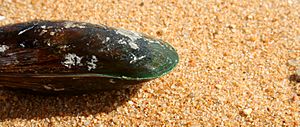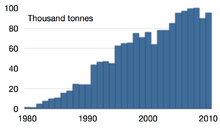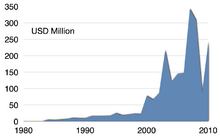New Zealand green-lipped mussel facts for kids
Quick facts for kids New Zealand green-lipped mussel |
|
|---|---|
 |
|
| Close-up of the green lip of this mussel species | |
| Scientific classification | |
| Genus: |
Perna
|
| Species: |
canaliculus
|
| Synonyms | |
|
|
The New Zealand green-lipped mussel (scientific name: Perna canaliculus) is a special type of bivalve mollusc found only in New Zealand. It's also known as the New Zealand mussel or greenshell mussel. In the Māori language, it's called kuku or kutai. These mussels are very important to New Zealand's economy because they are grown on farms.
Contents
Where Green-Lipped Mussels Live
You can find Perna canaliculus all around the main islands of New Zealand. They usually live in the ocean below the area that gets covered and uncovered by tides. Sometimes, you can spot them in the tidal zone too. These mussels eat tiny ocean plants called phytoplankton.
What Green-Lipped Mussels Look Like
This shellfish is easy to spot because of its unique look. Unlike other mussels, it has dark brown or green shells with bright green edges, which is why it's called "green-lipped." It's also one of the biggest mussel species, growing up to 240 millimetres (9 in) long.
Farming Green-Lipped Mussels (Aquaculture)
The New Zealand green-lipped mussel is native to New Zealand. When it's farmed, it's sold under the name "Greenshell." This farming industry produces over 140,000 metric tons (150,000 short tons) of mussels each year. In 2009, this was worth more than NZ$250 million.
How Mussel Farms Get Their Babies
Mussel farming relies a lot on getting baby mussels, called "spat," from wild mussel groups. About 270 tonnes of wild spat are collected each year. These tiny mussels are attached to seaweed that washes up on Ninety Mile Beach in northern New Zealand. This beach provides about 80% of the baby mussels needed for the farms.
The amount of spat on the seaweed can vary a lot. Sometimes there are 200 to 2,000,000 per kilogram (91 to 907,185 per pound) of spat per kilogram of seaweed. The rest of the spat (about 20%) is collected using special ropes hung in the sea near mussel farms. Scientists are still learning how and why so much spat ends up on Ninety Mile Beach.
Growing Mussels on Farms
Mussel farming in New Zealand started in the 1970s and has grown a lot since then. Early farms used a method where mussels grew on floating rafts. But for larger farms, a new method was needed.
Today, mussel farms use a system called "longline aquaculture." This involves long ropes held up by large plastic buoys. These ropes are anchored to the seabed. Once the spat are collected, they are taken to the mussel farms. The spat-covered seaweed is placed inside a special stocking around a "dropper rope." These dropper ropes hang down into the water from the main longline ropes.
Soon, the stocking and seaweed break down, leaving the mussels attached to the rope. However, many spat can fall off the ropes, sometimes as many as 95%. This happens partly because young mussels can release themselves and float to a new spot. Farmers are trying to reduce this loss by making sure the spat are not stressed during transport.
Harvesting Mussels
Mussels are usually moved from the dropper ropes and re-attached once or twice as they grow. They are ready to harvest when they reach about 100 millimetres (4 in) in size. This usually takes 12 to 24 months. Special boats are used to pull the dropper ropes on board and strip the mussels off.
Mussel farming is very productive. In 2000, mussel farms produced 9.85 tonnes of mussels per hectare each year. This is much more protein per area than farming on land.
Future of Mussel Farming
Mussel farming is a fast-growing industry in New Zealand. In 2000, about 3,000 hectares (7,400 acres) of mussel farms were active. There were plans for another 30,000 hectares (74,000 acres) of farms. Most farms are small, less than 50 hectares (120 acres), and are in calm waters near the coast. But new technology allows bigger farms to be built further offshore in rougher waters.
Even after 15 years of research, most mussel farms still rely on wild spat. This is because collecting wild spat is much cheaper than breeding mussels in special hatcheries. However, hatcheries might become more important in the future. They could help farmers breed mussels with special traits, like faster growth. Hatcheries also offer a more reliable supply of spat, especially when wild spat numbers are low.
Quality and Environment
The New Zealand greenshell mussel industry has some of the highest quality standards in the world. Both the mussels and the seawater around the farms are regularly tested. They check for harmful substances like toxins, bacteria, and heavy metals. These strict rules help make sure seafood is safe and healthy for people around the world.
The New Zealand government also has laws to protect the environment from mussel farming. Because of these high standards, the Blue Ocean Institute, a conservation group, has called New Zealand greenshell mussels one of the top two "eco-friendly seafoods" in the world.
Mussel Houseguests: Pea Crabs
New Zealand green-lipped mussels sometimes have tiny guests living inside them called pea crabs. In 2015, researchers studied how male pea crabs find female crabs inside the mussels. They found that male crabs would leave their mussel homes to find a female crab nearby.
Scientists used special infrared cameras to watch the crabs at night. They saw male crabs gently touching the mussel's soft edge to get inside. They could even make the mussel open its shell wider, from 3.7 to 5.5 millimetres (9⁄64 to 7⁄32 in), to squeeze in!
Health Benefits of Green-Lipped Mussels
Some people believe that green-lipped mussels can help with inflammation in the body. This is because they might affect certain pathways that cause inflammation. However, scientific studies have not yet found strong evidence that taking green-lipped mussel supplements helps people with arthritis.



